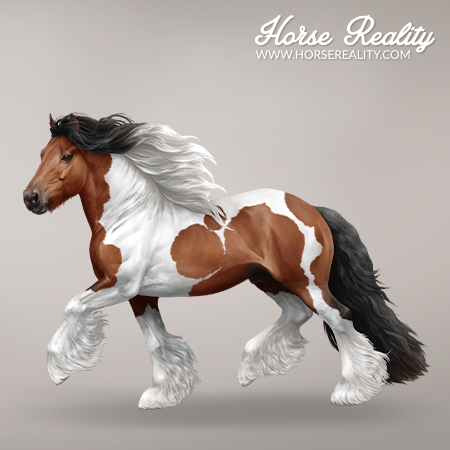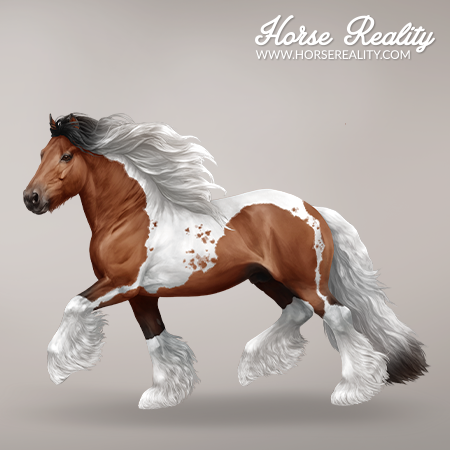Tobiano, also referred to as piebald (black and white) or skewbald (other colours and white) in the UK; is one of the white patterns present in horses.
¶ Phenotype
Tobiano has a rather vertical expression, and the amount of white can vary between horses. Usually, it creates white legs below the hocks and knees. In minimally expressed tobianos, this can be the only white they have. Tobiano can also be characterised by white patches on the coat that typically cross the topline (back) of the horse somewhere between the ears and tail. The patches usually have a rounded shape. Their edges are often sharp, but can also have a “halo effect”, with white hair being mixed with coloured ones. This differentiates tobiano from the frame overo pattern, which has a more horizontal expression, doesn't cross the topline, and has jagged edges.
Another typical characteristic of tobiano is a coloured neck/chest and flank area. If these are absent, it can be a sign that a different white pattern is present as well. Tobiano doesn't create markings on the head of the horse. Therefore, if a tobiano horse has facial markings, this means that they are caused by other white patterns or white markings. Tobianos can also have a two-coloured tail, with both white and coloured hairs.
Tobiano affects any base colour, but the presence of dilutions or grey may make the white pattern harder to see. Bay-based tobianos are sometimes called “tricoloured”, as they have white, black and reddish-coloured hairs.
Some tobiano horses may have small, coloured spots within the white patches. These are commonly called paw prints, ink spots, or cat tracks. This often occurs in horses homozygous for tobiano, but exceptions are possible.
| Tobiano - Irish Cob Horse | ||

|

|

|
Horses with both tobiano and another white pattern are often called “tovero”. They usually combine the characteristics of the present patterns and generally have more white than the individual patterns would cause.
| Tobiano + other white patterns - Irish Cob Horse |

|
¶ Genotype
The tobiano pattern is caused by a chromosome inversion very close to the KIT locus (ECA3). The tobiano allele (TO) is dominant; there may be some visual differences between horses that are heterozygous (TO/n) or homozygous (TO/TO) for tobiano, but genetic testing remains the most reliable method to distinguish the two.
Below, the resulting phenotype of each genotype is listed:
- TO/TO = Tobiano
- TO/n = Tobiano
- n/n = Not tobiano
Tobiano can be tested at the Laboratory.
Since it is located so close to the KIT gene and likely also interrupts its function, tobiano is usually treated as part of KIT. Therefore, horses normally can't be homozygous for tobiano and also have another KIT allele (some rare exceptions have been found in real life); TO/TO and roan, for example, is not possible.
- TO/RN = Tobiano roan
- TO/SB1 = Tobiano sabino1
- TO/Wx = Tobiano white spotting x
¶ Breeds
Tobiano is a very old mutation (~ 3500 years), and, as a result, is widespread in different breeds all over the world. The following table lists all breeds that can currently have the tobiano (TO) allele in-game:
| Breeds |
| Akhal-Teke Horse |
| Arabian Horse |
| Brabant Horse |
| Brumby Horse |
| Camargue Horse |
| Cleveland Bay |
| Exmoor Horse |
| Finnhorse |
| Fjord Horse |
| Friesian Horse |
| Haflinger Horse |
| Icelandic Horse |
| Irish Cob Horse |
| Kladruber Horse |
| Knabstrupper |
| Lipizzaner |
| Lusitano |
| Mongolian Horse |
| Mustang Horse |
| Namib Desert Horse |
| Noriker Horse |
| Norman Cob |
| Oldenburg Horse |
| Pantaneiro Horse |
| Pura Raza Española |
| Quarter Horse |
| Shetland Pony |
| Shire Horse |
| Suffolk Punch |
| Thoroughbred |
| Trakehner Horse |
| Welsh Pony |
¶ References
- Brooks, S. et al, A chromosome inversion near the KIT gene and the Tobiano spotting pattern in horses, Cytogenetic and Genome Research, 2007
- Bellone R., Sponenberg D. P., Equine Color Genetics, 4th Edition, 2017, Wiley-Blackwell
- UC Davis Veterinary Genetics Laboratory; https://vgl.ucdavis.edu/test/tobiano; Access: November 2022
- Generatio Center for Animal Genetics; https://generatio.de/en/guidance/lexicon/tobiano-horse; Access: November 2022